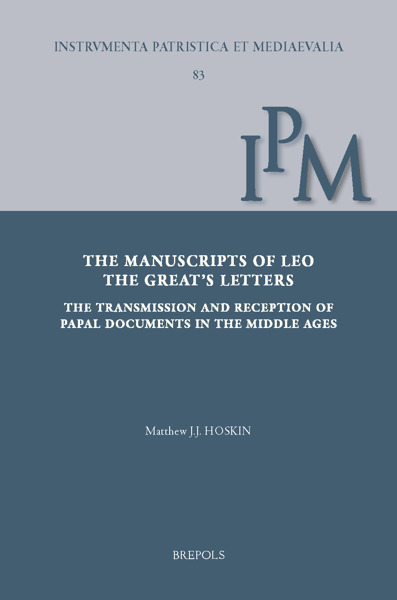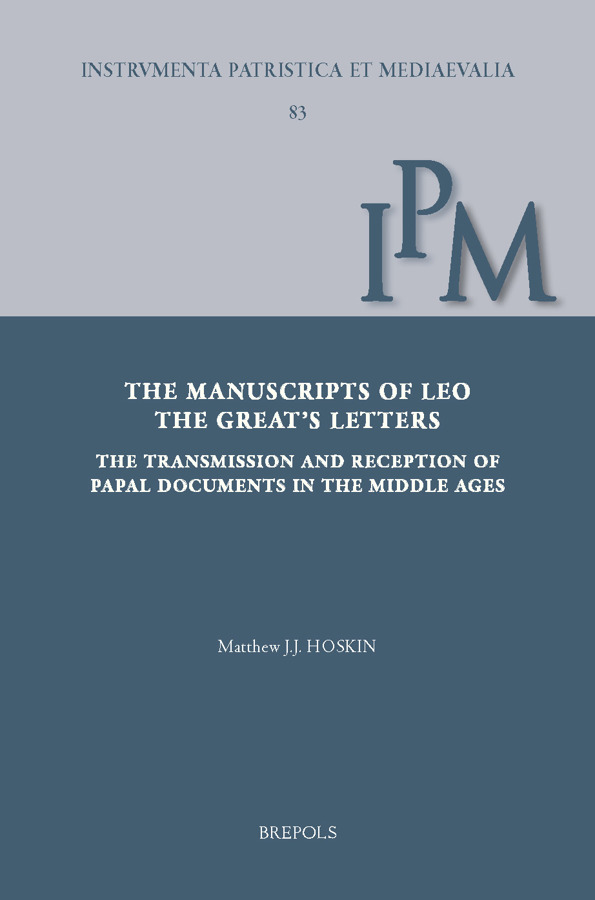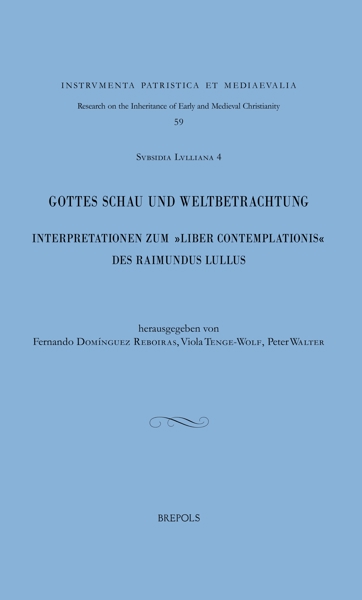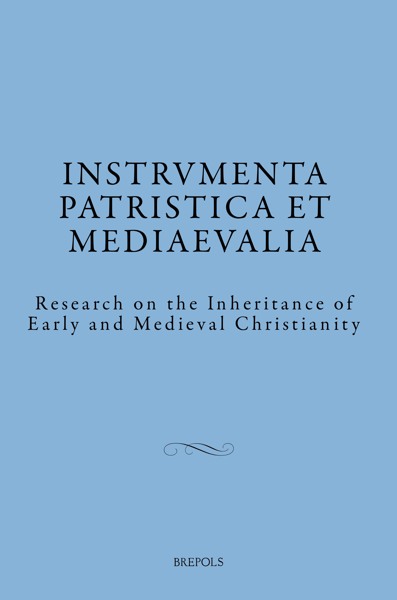
The Manuscripts of Leo the Great’s Letters
The Transmission and Reception of Papal Documents in Late Antiquity and the Middle Ages
Matthew Hoskin
- Pages: 516 p.
- Size:156 x 234 mm
- Illustrations:36 tables b/w.
- Language(s):English
- Publication Year:2022
- € 110,00 EXCL. VAT RETAIL PRICE
- ISBN: 978-2-503-58966-4
- Hardback
- Available
- € 110,00 EXCL. VAT RETAIL PRICE
- ISBN: 978-2-503-58967-1
- E-book
- Available
The enduring legacy of one of the greatest popes of Late Antiquity demonstrated through manuscripts of his letters
« L'ouvrage imposant de (M. J. J. Hoskin) n'est donc pas seulement, si j'ose dire, une magistrale investigation sur une tradition textuelle épineuse et buissonnante, il ne donne pas simplement, comme de surcroît, d'utiles outils pour accéder à la Correspondance de Léon, il est le socle, imprescindibile, d'une édition à venir. » (Paul Mattei, dans Recherches de Science Religieuse 112/2, avril-juin 2024, Bulletin de Patristique latine, p. 340-342)
“He has (…) covered an impressive amount of ground to present such a useful compendium of information. It is an invaluable addition to both knowledge and understanding of the reception and transmission of Pope Leo I’s letters.” (Rosamond McKitterick, in Early Medieval Europe, 31/3, 2023, p. 517)
“The 173 letters associated with pope Leo I (440-61) as their author or recipient are an indispensable source for the history of the Christian church in the middle of the fifth century. Given Leo’s importance as a statesman and a theologian, it is shocking that no modern edition of his complete correspondence exists. (...) The volume under review is propaedeutic to a new edition of the pope’s correspondence. The author offers a detailed survey of the reception history of Leo’s letters based on an in-depth examination of the manuscript evidence for their circulation in the Middle Ages. (...) This meticulous technical study of the transmission history of Leo’s letters is an essential step in the preparation of a new critical edition of the pope’s influential correspondence. (...) We can only hope that a new edition of Leo’s letters, informed by the scholarship on display on this book, will appear before long.” (Scott G. Bruce, in Bryn Mawr Classical Review 2023.01.26)
“If anything, the length of this review illustrates that for any study on the many collections addressed by Hoskin, his monograph demands thorough engagement, as it paves the way for any future study on this broad topic. (...) For each letter, Hoskin gives the most recent edition and an overview of the collections which contain the letter. With his painstaking work, Hoskin has succeeded in delivering the much-needed “prolegomena” to a new critical edition of the letters of Leo the Great.” (Aäron Vanspauwen, in Plekos 24, 2022, p. 587–599; URL: hoskin.pdf">https://www.plekos.uni-muenchen.de/2022/r>hoskin.pdf)
"Como se puede comprobar, se trata de una obra muy valiosa, de consulta obligada para todos aquellos interesados en el estudio de las epístolas leoninas y su transmisión." (Joaquin Sedano, Zeitschrift der Savigny-Gesellschaft für Rechtsgeschichte, Kanonistische Abteilung, 111, 2025, 302)
« Les mérites de cette remarquable étude sont multiples. On se contentera de n’en mentionner que deux : primo, elle remplit parfaitement la fonction de la collection dans le sein de laquelle l’ouvrage est publié « Instruments patristiques et médiévaux », car maintenant les chercheurs peuvent trouver rapidement une information complète et de qualité pour chaque lettre de Léon le Grand ; secundo, les analyses précises des manuscrits et la comparaison des variantes sont et seront très utiles pour une nouvelle édition de la correspondance de ce pape. » (Kristina Mitalaitė, in Revue des Sciences philosophiques et théologiques 106/4, 2022, Bulletin d’Histoire des doctrines médiévales, p. 615)
« Avec ce travail minutieux et abondamment sourcé, M. H. montre comment les collections de lettres de Léon ont été extraites d’autres collections, réarrangées, amplifiées, pendant près de dix siècles. Son travail très riche, muni d’index des manuscrits et des collections qui aideront plus d’une personne, sera un instrument de travail utile aussi bien aux philologues qu’aux historiens.» (Marie Frey Rébeillé-Borgella, dans Revue d'Histoire Ecclésiastique, 119/1-2, 2024, p. 317)
Matthew J J Hoskin has a Ph.D. in Classics and the History of Christianity, awarded by the University of Edinburgh in 2015. Since then, he has had the opportunity to study manuscripts through fellowships at Rome and Durham, as well as to teach Latin and Roman History at Edinburgh and the University of British Columbia.
This book explores the transmission of the letters of Leo the Great (pope, 440-461). After setting out the contours of Leo’s papacy and the factors contributing to the sending and subsequent transmission of his letters to posterity, it deals in detail with around sixty collections of Leo’s letters and over 300 manuscripts ranging in date from the sixth up to the sixteenth century. Each period of the Middle Ages is introduced as the context for collecting and copying the letters, and the relationships between the letter collections themselves are traced. The result is a survey of the impact of Leo the Great upon Latin Christendom, an impact that was felt in theology and canon law, especially from the age of the Emperor Justinian to the Council of Ferrara-Florence, and moving through the major monasteries of Europe from Corbie to Clairvaux. At every cultural Renaissance, Leo was a presence, being copied, rearranged, interpreted, and eventually printed. This book is a testament to the legacy of one of the mid-fifth century’s most influential figures.
Introduction
Chapter 1: Leo’s Letters in History, Canon Law, and Theology
1.1 Leo’s Letters in History and Canon Law; 1.2 Leo’s Letters and the History of Theology
Chapter 2: Editing Leo’s Letters
2.1 Giovanni Andrea Bussi; 2.2 The Sixteenth Century; 2.3 The Seventeenth Century; 2.4 Pasquier Quesnel; 2.5 Giacomo and Pietro Ballerini; 2.6 Epistolae Arelatenses genuinae (MGH Epist. 3), ed. Gundlach; 2.7 Collectio Avellana I (CSEL 35), ed. Günther; 2.8 The Tome of Pope Leo the Great, by Blakeney; 2.9 Eduard Schwartz; 2.10 Carlos Silva-Tarouca; 2.11 Hubert Wurm; 2.12 Benedikt Vollmann; 2.13 Corpus Fontium Manichaeorum Series Latina 1; 2.14 The Case for a New, Complete, Critical Edition
Chapter 3: Pre-Carolingian Canonical Collections
3.1 The Earliest, Unknown Period of Transmission
3.2 Pre-Carolingian Canonical Collections and the renaissance gélasienne: a. Collectio Frisingensis Prima (F); b. Collectio Diessensis (Di); c. Collectio Quesnelliana (Q); d. Collectio Vaticana (L); e. Collectio Sanblasiana (Sa); f. Collectio Dionysiana (D); g. Collectio Dionysiana Bobiensis (D-b); h. Cresconius, Concordia canonum; i. Collectio Teatina (Te); j. Collectio Corbeiensis (C); k. Collectio Pithouensis (P); l. Collectio (ecclesiae) Thessalonicensis (T); m. Collectio Avellana; n. Collectio Arelatensis (Ar); o. Collectio Albigensis (Al); p. Collectio Remensis (Re); q. Collectio Coloniensis (K); r. Collectio Sancti Mauri (M); s. Collectio Vetus Gallica; t. Epitome Hispana; u. Collectio Hispana (S); v. Collectio Hispana Systematica; w. Ragyndrudis Codex (Codex Bonifatianus II)
Chapter 4: Chalcedonian Collections
Context of the Collections;
4.1 Latin Chalcedonian Collections: a. Ballerini Collection 17 (Early Latin Acta; Ac); b. Collection of Vat. lat. 1322 (A); c. Rusticus’ Acta (Ru); d. Versio Gestorum Chalcedonensium antiqua correcta (Ch); e. Collectio Novariensis (N); f. Collectio Casinensis (Ca); g. Collectio Grimanica (G); h. Codex Encyclius; i. Verona LIX (57); j. A Carolingian fragment of the Tome
4.2 The Greek Transmission of Leo’s Letters: a. Collection M; b. Collection B; c. Collection H
Chapter 5: The Carolingian Tradition of Manuscripts
5.1 The Carolingian Context
5.2 Carolingian Canonical Collections: a. Collectio Dionysio-Hadriana (D-h); b. Collectio Hadriano-Hispanica (H-s); c. Collectio Dionysiana adaucta (D-a); d. Collectio Hispana Gallica (S-g); e. Collectio Hispana Gallica Augustodunensis (S-ga); f. Pseudo-Isidorus Mercator, Decretales (I); i. Context; ii. Hinschius’ Classification System; iii. Hinschius A/B & B (Ballerini Collection 10; I-b); iv. Hinschius A1 (I-a); v. The Cluny Recension, or Yale Pseudo-Isidore (Y); vi. Hinschius Class C (I-c); g. The canon law manuscript Vat. Reg. lat. 423; h. Systematic as well as Unorganised Collections of Extracted Canons
5.3 Other Carolingian Collections; a. Collectio Bobbiensis (B); b. Collectio Ratisbonensis (E); c. Ep. 28 in the Roman Homiliary; d. Ep. 28 in the Homiliary of Agimond
Chapter 6: Post-Carolingian Collections and the Age of Reform
6.1 Introduction to the High and Late Mediaeval Contexts
6.2 Post-Carolingian Canonical Collections: a. Collectio Lanfranci; b. Collectio Britannica; c. The Collection of William of Malmesbury; d. Systematic as well as Unorganised Collections of Extracted Canons Before Gratian; e. The Concordia discordantium canonum (Decretum) of Gratian
6.3 Other Post-Carolingian Collections: a. Ballerini Collection 20; b. Ballerini Collection 21 (Y-a); c. Ballerini Collection 22 (22); d. Ballerini Collection 23 (23); e. Ballerini Collection 24 (24); f. Collectio Florentina (Ballerini Collection 13; m); g. Collection of 73 Letters (73); h. Ashburnham 1554; i. Collection of Vat. Reg. lat. 293; j. An eleventh-century pair of Leo’s letters; k. Milanese Sermon Collection D; l. Ambrosiana C.50.inf.; m. Vat. Ross. 159; n. Eugenius IV’s collection; o. Later Manuscripts of the Tome; p. Other high and late medieval manuscripts with only one Leo letter
Chapter 7: Conspectus of the Letters of Pope Leo the Great
Conclusion
Appendix: Proto-Collections Analysed in this Book
Bibliography of Primary Sources
Bibliography of Secondary Works




